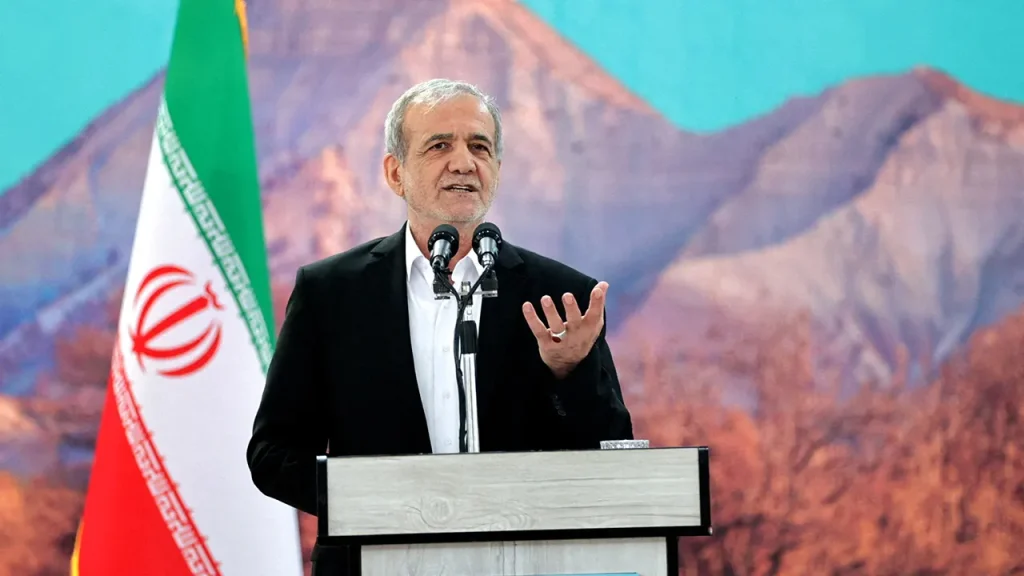In a shocking turn of events last month, Iranian President Masoud Pezeshkian reportedly suffered a minor leg injury while reportedly escaping an Israeli airstrike aimed at disrupting key government operations in Tehran. The incident occurred on June 16 at a secure facility as Pezeshkian was engaged in a meeting with senior officials. This airstrike is characterized by its severity, involving six targeted missiles aimed at critical entry points to prevent any evacuation attempts, escalating tensions in a region already fraught with conflict.
| Article Subheadings |
|---|
| 1) Overview of the Incident |
| 2) Details of the Attack |
| 3) Current Political Landscape |
| 4) Broader Implications of the Strike |
| 5) Conclusion on Regional Stability |
Overview of the Incident
On June 16, Iranian officials reported an airstrike allegedly conducted by Israeli forces targeting a secure government facility in Western Tehran. During a high-level meeting involving President Masoud Pezeshkian and other senior officials, the strike disrupted their discussions, leading to chaos. The severity of the attack has been characterized by reports describing six bombs or missiles that aimed to incapacitate entry and exit points, thus isolating the officials within the facility. These details were disclosed by Iran’s semi-official Fars news agency, further intensifying the reported dangers of the ongoing tensions in the region.
Details of the Attack
Sources detail that the Israeli airstrike involved a calculated approach, targeting crucial entry and exit points to the facility to minimize the likelihood of evacuation. As a result of the blasts, power was cut to the targeted floor, limiting communications and responses from those trapped inside. Eyewitness accounts indicate that the escape was fraught with challenges, as several officials, including Pezeshkian, reportedly suffered minor injuries while hastily exiting through an emergency hatch. The overall assessment suggests a highly strategic and meticulously planned operation designed to destabilize Iranian leadership amid ongoing conflicts in the region.
Current Political Landscape
The airstrike marks a significant escalation in the long-standing conflict between Israel and Iran, particularly in light of Iran’s recent efforts to expand its military capabilities. Israeli authorities have explicitly stated that their military actions aim to disrupt Iran’s attempts to develop nuclear weapons. This attack is said to have occurred during a larger 12-day conflict that is viewed as part of a broader offensive against Iranian interests, especially targeting military leaders and scientists involved in nuclear proliferation. This backdrop compels analysts to consider the growing tensions not only between these two nations but also with U.S. involvement, which has shown signs of increasing aggression as evidenced by its own military strikes targeting Iranian nuclear facilities.
Broader Implications of the Strike
The implications of this airstrike extend beyond immediate physical damage and injuries. Analysts argue that such actions may provoke further retaliation from Iran, expanding the conflict beyond its borders. With Iranian leaders vowing to retaliate for these attacks, the potential for escalation increases exponentially. Israel’s targeted campaigns against Iranian military leadership form part of a broader strategy to hinder the latter’s capacity to achieve nuclear capabilities, a move that many deem necessary but which could further complicate international relationships. As Western powers engage with Iran concerning its nuclear aspirations, the recent conflict sheds light on the fragility of diplomatic resolutions when military actions are at play.
Conclusion on Regional Stability
The incident surrounding Pezeshkian and the airstrike raises critical questions about the future of stability in the Middle East. The ongoing conflict and its ramifications not only affect Iranian leadership but also have the potential to redraw alliances and strategies among regional and global powers. The persistent aggression could lead to a re-evaluation of security policies by the U.S. and its allies in the context of Iranian military advancements. As tensions remain high, observers recommend close monitoring of both Israeli and Iranian responses to ensure the potential for a broader conflict is curtailed.
| No. | Key Points |
|---|---|
| 1 | An airstrike on June 16 targeted Iranian President Masoud Pezeshkian during a meeting. |
| 2 | The strike involved six bombs aimed at isolating officials from making a successful escape. |
| 3 | Israeli military intent focuses on hindering Iran’s nuclear ambitions through strategic strikes. |
| 4 | The conflict highlights the volatility of regional security and the prospects for future escalation. |
| 5 | The situation calls for close international observation to mitigate potential larger conflicts. |
Summary
The reported airstrike targeting Iranian President Masoud Pezeshkian represents a critical juncture in the ongoing conflicts between Israel and Iran. As these events unfold, the broader implications on regional stability cannot be overlooked. The tension underscores the delicate balance required in dealing with Iran’s nuclear ambitions while navigating the increasingly complex political landscape. Observers warn that without diplomatic interventions, the potential for further military engagements may remain high, placing both nations in perilous positions.
Frequently Asked Questions
Question: What was the outcome of the airstrike on President Pezeshkian?
The airstrike resulted in a minor leg injury to Pezeshkian while he and other officials managed a chaotic escape through an emergency hatch.
Question: Why did the Israeli military target Iranian officials?
The Israeli military aimed to disrupt Iran’s nuclear capabilities and prevent the regime from developing nuclear weapons.
Question: What are the potential consequences of this conflict for the region?
The ongoing tension has the potential to escalate into broader conflicts, influencing international relations and security policies in the region.


